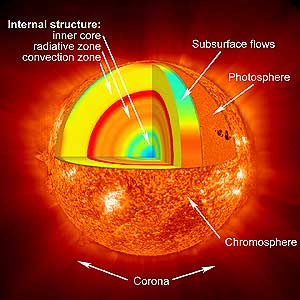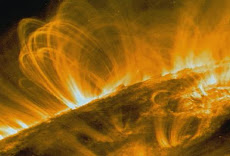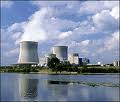

By
Wele Gwir
The Sun is the most prominent feature in our solar system. It is the largest object and contains approximately 98% of the total solar system mass. One hundred and nine Earths would be required to fit across the Sun's disk, and its interior could hold over 1.3 million Earths. The Sun's outer visible layer is called the photosphere and has a temperature of 6,000°C (11,000°F). This layer has a mottled appearance due to the turbulent eruptions of energy at the surface.
Solar energy is created deep within the core of the Sun. It is here that the temperature (15,000,000° C; 27,000,000° F) and pressure (340 billion times Earth's air pressure at sea level) is so intense that nuclear reactions take place. This reaction causes four protons or hydrogen nuclei to fuse together to form one alpha particle or helium nucleus. The alpha particle is about .7 percent less massive than the four protons. The difference in mass is expelled as energy and is carried to the surface of the Sun, through a process known as convection, where it is released as light and heat. Energy generated in the Sun's core takes a million years to reach its surface. Every second 700 million tons of hydrogen are converted into helium ashes. In the process 5 million tons of pure energy is released; therefore, as time goes on the Sun is becoming lighter.
The chromosphere is above the photosphere. Solar energy passes through this region on its way out from the center of the Sun. Faculae and flares arise in the chromosphere. Faculae are bright luminous hydrogen clouds which form above regions where sunspots are about to form. Flares are bright filaments of hot gas emerging from sunspot regions. Sunspots are dark depressions on the photosphere with a typical temperature of 4,000°C (7,000°F).
The corona is the outer part of the Sun's atmosphere. It is in this region that prominences appears. Prominences are immense clouds of glowing gas that erupt from the upper chromosphere. The outer region of the corona stretches far into space and consists of particles traveling slowly away from the Sun. The corona can only be seen during total solar eclipses.
The Sun appears to have been active for 4.6 billion years and has enough fuel to go on for another five billion years or so. At the end of its life, the Sun will start to fuse helium into heavier elements and begin to swell up, ultimately growing so large that it will swallow the Earth. After a billion years as a red giant, it will suddenly collapse into a white dwarf -- the final end product of a star like ours. It may take a trillion years to cool off completely.
Sun Statistics
Mass (kg) 1.989e+30
Mass (Earth = 1) 332,830
Equatorial radius (km) 695,000
Equatorial radius (Earth = 1) 108.97
Mean density (gm/cm^3) 1.410
Rotational period (days) 25-36*
Escape velocity (km/sec) 618.02
Luminosity (ergs/sec) 3.827e33
Magnitude (Vo) -26.8
Mean surface temperature 6,000°C
Age (billion years) 4.5
Principal chemistry
Hydrogen
Helium
Oxygen
Carbon
Nitrogen
Neon
Iron
Silicon
Magnesium
Sulfur
All others
92.1%
7.8%
0.061%
0.030%
0.0084%
0.0076%
0.0037%
0.0031%
0.0024%
0.0015%
0.0015%
• The Sun's period of rotation at the surface varies from approximately 25 days at the equator to 36 days at the poles. Deep down, below the convective zone, everything appears to rotate with a period of 27 days. (www.solarviews.com)
Can The Sun Hurt Us?
Prolonged exposure to the sun’s rays can result in mild to severe burning of the top layers of the skin.
A sunburn is a burn to living tissue, such as skin, which is produced by overexposure to ultraviolet (UV) radiation, commonly from the sun's rays. Usual mild symptoms in humans and animals include red or reddish skin that is hot to the touch, general fatigue, and mild dizziness. An excess of UV radiation can be life-threatening in extreme cases. Exposure of the skin to lesser amounts of UV radiation will often produce a suntan.
Excessive UV radiation is the leading cause of primarily non-malignant skin tumors.[1][2] Sunscreen is widely agreed to prevent sunburn, although some scientists argue that it may not effectively protect against malignant melanoma, which is either caused by a different part of the ultraviolet spectrum or is not caused by sun exposure at all.[3][4] Clothing, including hats, is considered the preferred skin protection method. Moderate sun tanning without burning can also prevent subsequent sunburn, as it increases the amount of melanin, a skin photoprotectant pigment that is the skin's natural defense against overexposure. Importantly, both sunburn and the increase in melanin production are triggered by direct DNA damage. When the skin cells' DNA is damaged by UV radiation, type I cell-death is triggered and the skin is replaced.[5] Malignant melanoma may occur as a result of indirect DNA damage if the damage is not properly repaired. Proper repair occurs in the majority of DNA damage, and as a result not every exposure to UV results in cancer. The only cure for sunburn is slow healing, although some skin creams can help with the symptoms.(Wikipedia)
There has been continuous controversy over the use of sunscreens. Some say that these creams can help prevent skin cancer; others say they block the absorption of Vitamin D. Can this vitamin prevent cancer? Here is what Wikipedia has to say:
Cancer The molecular basis for thinking vitamin D has the potential to prevent cancer lies in its role in a wide range of cellular mechanisms central to the development of cancer.[104] These effects may be mediated through vitamin D receptors expressed in cancer cells.[22] Polymorphisms of the vitamin D receptor (VDR) gene have been associated with an increased risk of breast cancer.[105] Women with mutations in the VDR gene had an increased risk of breast cancer.[106]
A 2006 study using data on over 4 million cancer patients from 13 different countries showed a marked increase in some cancer risks in countries with less sun and another metastudy found correlations between vitamin D levels and cancer. The authors suggested that intake of an additional 1,000 international units (IU) (or 25 micrograms) of vitamin D daily reduced an individual's colon cancer risk by 50%, and breast and ovarian cancer risks by 30%.[107][108][109][110] Low levels of vitamin D in serum have been correlated with breast cancer disease progression and bone metastases.[105] However, the vitamin D levels of a population do not depend on the solar irradiance to which they are exposed.[111][112][113][114] Moreover, there are genetic factors involved with cancer incidence and mortality which are more common in northern latitudes.[115][116]
A 2006 study found that taking the U.S. RDA of vitamin D (400 IU per day) cut the risk of pancreatic cancer by 43% in a sample of more than 120,000 people from two long-term health surveys.[117][118] However, in male smokers a 3-fold increased risk for pancreatic cancer in the highest compared to lowest quintile of serum 25-hydroxyvitamin D concentration has been found.[119]
A randomized intervention study involving 1,200 women, published in June 2007, reports that vitamin D supplementation (1,100 international units (IU)/day) resulted in a 60% reduction in cancer incidence, during a four-year clinical trial, rising to a 77% reduction for cancers diagnosed after the first year (and therefore excluding those cancers more likely to have originated prior to the vitamin D intervention).[120][121] Although the study was criticized on several grounds[122] including failing to take into account a long term overall increase in cancer found in a another study of vitamin D intake[123] in 2007 the Canadian Cancer Society, (a national community-based organization of volunteers) recommended that all adults begin taking 1,000 IU per day (five times more than the government says they need) .[124][125] A US National Cancer Institute study analyzed data from the third national Health and Nutrition Examination Survey to examine the relationship between levels of circulating vitamin D in the blood and cancer mortality in a group of 16,818 participants aged 17 and older. It found no support for an association between 25(OH)D and total cancer mortality. However, the study did find that "[c]olorectal cancer mortality was inversely related to serum 25(OH)D level, with levels 80 nmol/L or higher associated with a 72% risk reduction (95% confidence interval = 32% to 89%) compared with lower than 50 nmol/L, Ptrend = .02."[126] Unlike other studies, this one was carried out prospectively — meaning that participants were followed looking forward — and the researchers used actual blood tests to measure the amount of vitamin D in blood, rather than trying to infer vitamin D levels from potentially inaccurate predictive models.[114][127] (Wikipedia)
Our ancient ancestors used to worship the sun as a source of life-giving light and power. They knew, as we do now, that it can kill if not balanced by life enhancing rain. The rainbow could be, perhaps, the symbol of this balance. Today this most brilliant star in our heavens continues to be misunderstood. Constant bickering over its effects on the climate, health and well-being of the inhabitants of this planet will rage for years to come. A healthy respect, not fear, for the sun is needed if our future generations are to benefit from our study and understanding of this mysterious and glowing orb.





